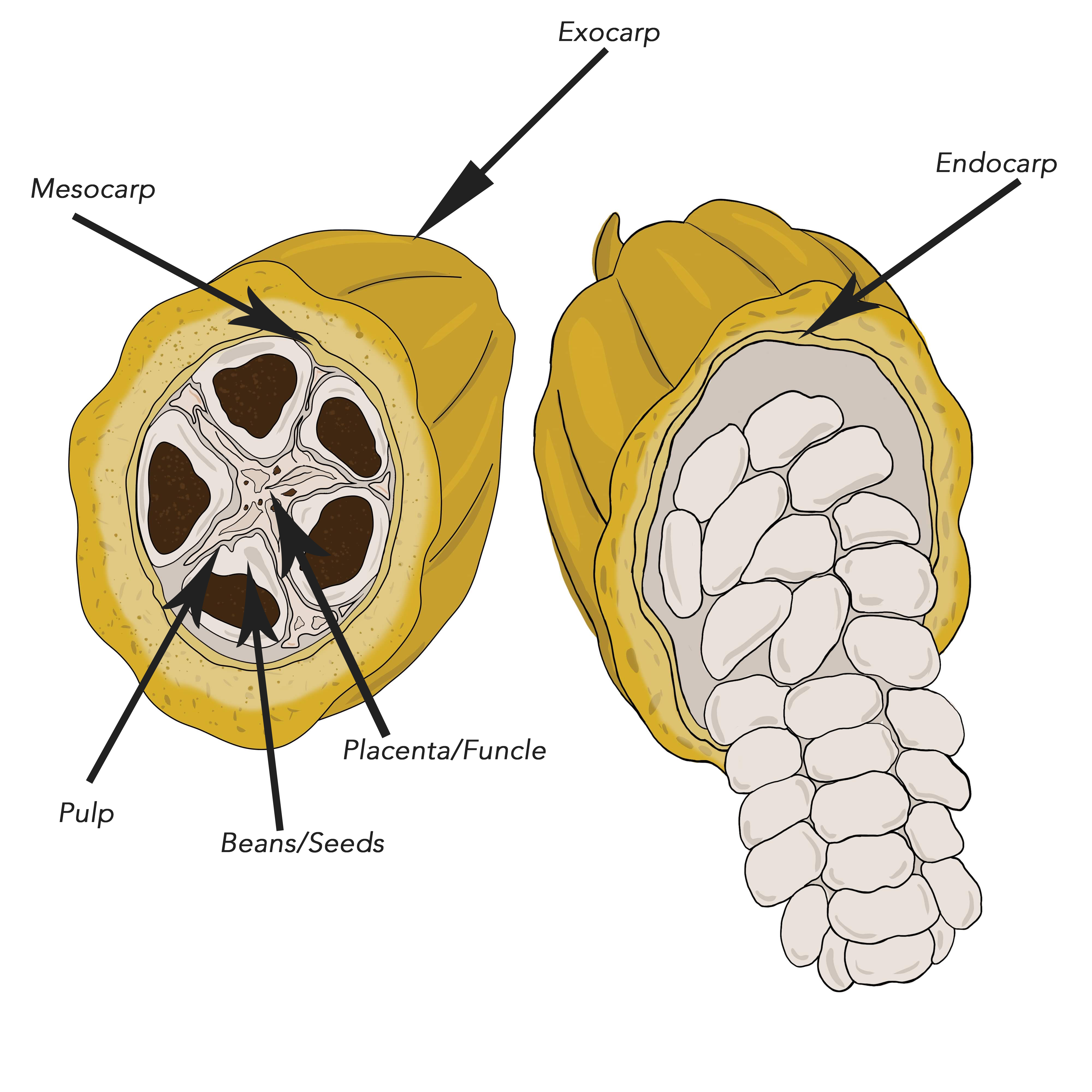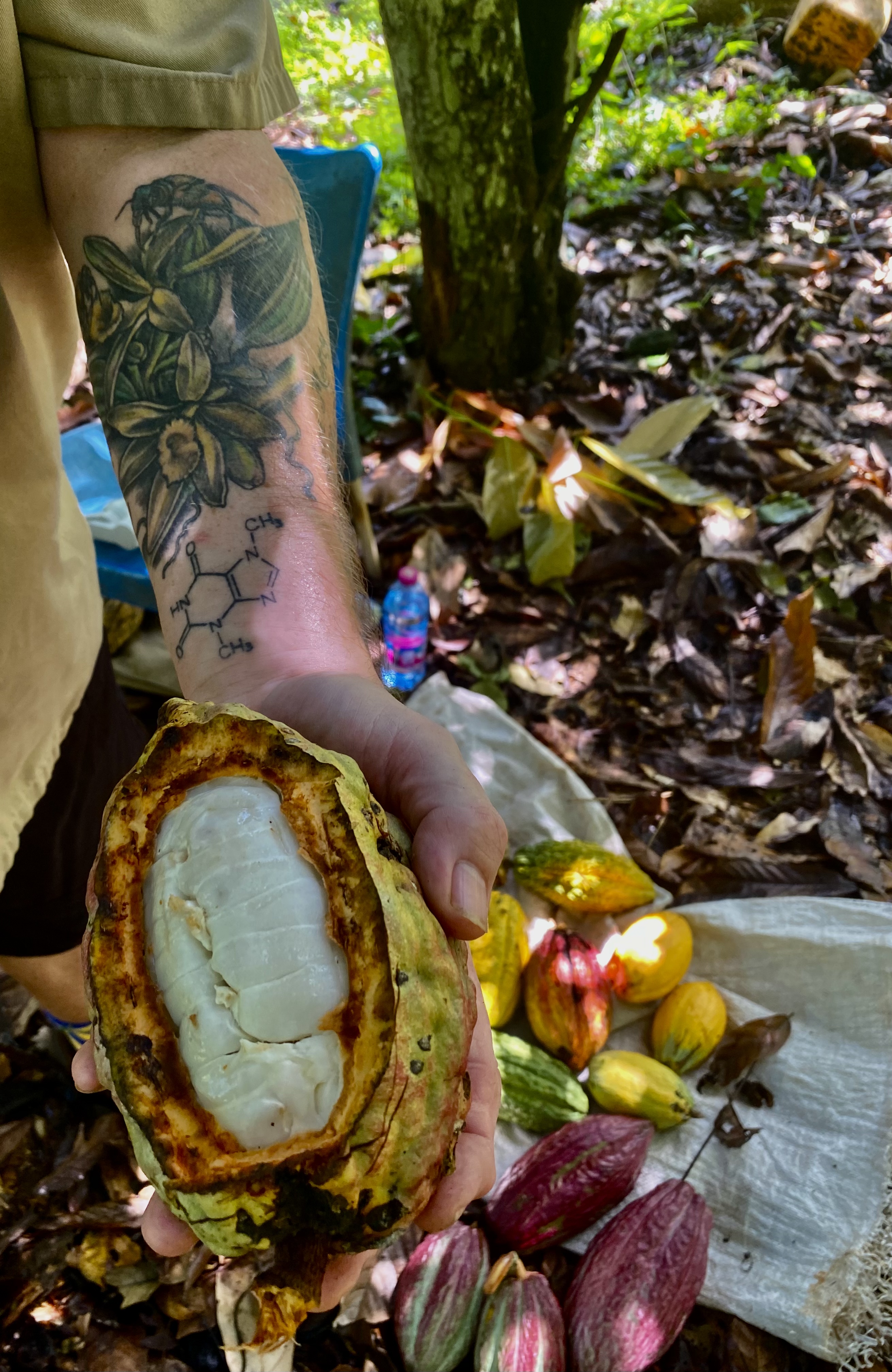 Cocoa pods appear and sprout from the floral pillows on the trunk and major branches of the cocoa tree.
Cocoa pods appear and sprout from the floral pillows on the trunk and major branches of the cocoa tree.
Their looks varie depending on the variety, genetics, and where they are from, but they all look the same inside:
Exocarp,
Mesocarp,
Endocarp,
Placenta/Funicle,
Beans/Seeds
Pulp.
The Exocarp is the hard thick outer shell of the pod.
It has a slightly gnarled surface that protects the whole fruit, and when ripe, cocoa exocarp comes in a range of colours, which depend on two things: the pod’s natural colour and its ripeness level. it takes four to five months for the pod to grow and fully ripen.
The colour tells us that it’s ready, the colour also varies through many different shades, but there are two basic colours, green and red. The green colour (yellow when it’s mature) is specific to the forestero and Nacional cocoa, while criollo and trinatario are red or purple (orange when mature)
The Mesocarp
A thick, hard layer sits beneath the exocarp, It’s usually slightly woody but makes a good bar snak when deep fried and seasoned.
The Endocarp
The endocarp follows the mesocarp and is the final layer of the “shell” surrounding the cacao beans and pulp, so it becomes slightly moister and softer, it adds structure and rigidity to the pod.
Although crucial for the plant’s health the layers of the cacao pod (exocarp, mesocarp, and endocarp) dont affect the flavour in any way.
 The Cacao Pulp
The Cacao Pulp
The seeds are covered in a white, sticky pulp or mucilage that is removed during fermentation. the pulp is high in sugar, it can be consumed on its own.
you can make juice, liquor, beverages, ice cream, and jams with it
The Rachis/Funicle & Placenta
It’s not just seeds that lie inside the pulp. You’ll also find the funicle intertwined among them. This is a thin, thread-like stalk that attaches the seeds to the placenta. The funicle and placenta, like the pulp, break down during fermentation. i have heared of people using them in flour.
Beans/Seeds
And finally, we reach the most important part – for chocolate makers the beans or seeds.
These are what finally get turned into our chocolate bars and drinks, the cocoa beans, which are covered in pulp, in neat rows that go around the placenta in such a way that it looks like a corn cob.
Can we use the whole pod?
We have to! it just isnt commercially viable for a farmer to throw 82% of their harvest away, if the cocoa seeds are the only part of the fruit that ends up in chocolate, we have to find a use for the waste.
We’ve already mentioned that pulp can be consumed on its own. In some countries i have seen, the cococa by-products being used to feed livestock.
Cocoa pods uses are varied. Whilst on a cocoa safari in Sao Tome event we served served a dinner with more than 30 different [cocoa] dishes that varied from cocktails breakfast juice soups, rice, meats, desserts, and others. we even used the pods as cooking and drinking vessels.
Even when the by-products aren’t consumed, they can still be used.
The shell of the pod, once harvested, is left in the plantation to encourage the Forcipomyia fly (principle insect that helps in the pollination of the cocoa flower) to lay its eggs in there.
Then [the shell] is reincorporated in the soil once it’s degraded, some farmers make compost with the shells because they are rich in potassium and help to improve organic matter in the soil.
